Overview of the Application of Artificial Intelligence in China’s Park-Level Integrated Energy System: Current Status, Challenges, and Future Paths
Abstract
1. Overview of the Development of Demand-Side Park-Level Integrated Energy Systems
2. Technology Status and Bottlenecks in the Park-Level Integrated Energy Sector
2.1. Distributed Renewable Energy Output and User Load Forecasting
2.1.1. Application Status: Initial Integration of Traditional Models and Data-Driven Techniques
2.1.2. Bottleneck Problems: Deep Contradictions Between Data–Mechanism Synergy and Spatiotemporal Correlation Modeling
- (1)
- Limitations of the Data-Driven Paradigm and Challenges of Dual-Driven Fusion
- (2)
- Spatiotemporal Correlation Modeling Dilemma for Collaborative Source–Load Forecasting
- (3)
- Differences in Multi-Time Scale Uncertainty Modeling
- (4)
- Bottleneck of Association Analysis for Knowledge Transfer Under Data Scarcity
2.2. Integrated Energy System Scheduling Decision-Making
2.2.1. Application Status: Conventional Algorithms Dominated by Shallow Reinforcement Learning Pilots
2.2.2. Bottleneck Problems: Synergistic Dilemma of Multi-Energy Coupling and Multi-Agent Game
- (1)
- Multi-Timescale Conflict in Fine Scheduling
- (2)
- Equilibrium Diversity Requirements of a Multi-Agent Game
2.3. Fault Diagnosis and Response Management
2.3.1. Application Status: Primary Application of Threshold Alarms and Image Recognition
2.3.2. Bottlenecks: Technical Bottlenecks in Cross-Modal Diagnosis and Fast Recovery
- (1)
- Semantic Gap in Multimodal Data Fusion
- (2)
- Dilemma of Causal Correlation Decoupling for Composite Faults
- (3)
- Dual Timeliness Constraints for Fast Recovery Decision-Making
2.4. Analysis of Key Indicators for AI Methods in Park-Level Integrated Energy Systems
3. Core Development Directions of AI Technology in Park-Level Integrated Energy Sector
3.1. Cross-Modal, Transferable Source–Load Collaborative Forecasting
3.2. Collaborative Scheduling for Multi-Agents and Heterogeneous Energy Sources
- (1)
- Multi-Agent Deep Reinforcement Learning (MADRL) for Multi-Agents
- (2)
- Multi-Timescale Optimization of Heterogeneous Energy via Neural Differential Equations (NDEs)
3.3. Cross-Modal, Large-Model Security O&M Systems
- (1)
- Cross-Modal Comparative Learning (CMCL)
- (2)
- Large Language Models (LLMs) for Security O&M Scenarios
4. Suggested Development Path for the Park-Level Integrated Energy Sector
- (1)
- Source–Load Multi-Temporal–Spatial Collaborative Forecasting
- (2)
- Multi-Energy and Multi-Agent Collaborative Scheduling
- (3)
- Cross-Modal Diagnosis and Rapid Recovery
5. Conclusions
Author Contributions
Funding
Conflicts of Interest
References
- Li, Q.; Qin, Z.; Zhang, L.; Yang, Y.; Deng, J.; Guo, J. Multi-objective optimization scheduling and flexibility margin study in integrated energy systems based on different strategies. J. Clean. Prod. 2024, 449, 141698. [Google Scholar] [CrossRef]
- Tan, J.; Wu, Q.; Zhang, X. Optimal planning of integrated electricity and heat system considering seasonal and short-term thermal energy storage. IEEE Trans. Smart Grid 2022, 14, 2697–2708. [Google Scholar] [CrossRef]
- Jia, Q.; Jiao, W.; Chen, S.; Yan, Z.; Sun, H. Trustworthy Cloud-Edge Collaboration Framework for Scheduling Distributed Energy Resources in Distribution Networks. IEEE Trans. Smart Grid 2025, 16, 2691–2694. [Google Scholar] [CrossRef]
- Binini, G.M.; Munda, J.L.; Popoola, O.M. Optimal location, sizing and scheduling of distributed energy storage in a radial distribution network. J. Energy Storage 2024, 94, 112499. [Google Scholar] [CrossRef]
- Armghan, H.; Xu, Y.; Bai, X.; Ali, N.; Chang, X.; Xue, Y. A tri-level control framework for carbon-aware multi-energy microgrid cluster considering shared hydrogen energy storage. Appl. Energy 2024, 373, 123962. [Google Scholar] [CrossRef]
- Cui, J.; Gao, Q.; Li, D. Improved long short-term memory network based short term load forecasting. In Proceedings of the 2019 Chinese Automation Congress (CAC), Hangzhou, China, 22–24 November 2019; IEEE: New York, NY, USA, 2019. [Google Scholar]
- Habbak, H.; Mahmoud, M.; Metwally, K.; Fouda, M.M.; Ibrahem, M.I. Load forecasting techniques and their applications in smart grids. Energies 2023, 16, 1480. [Google Scholar] [CrossRef]
- Wan, A.; Chang, Q.; Al-Bukhaiti, K.; He, J. Short-term power load forecasting for combined heat and power using CNN-LSTM enhanced by attention mechanism. Energy 2023, 282, 128274. [Google Scholar] [CrossRef]
- Yu, L.; Sun, Y.; Xu, Z.; Shen, C.; Yue, D.; Jiang, T.; Guan, X. Multi-agent deep reinforcement learning for hvac control in commercial buildings. IEEE Trans. Smart Grid 2020, 12, 407–419. [Google Scholar] [CrossRef]
- Tan, M.; Liao, C.; Chen, J.; Cao, Y.; Wang, R.; Su, Y. A multi-task learning method for multi-energy load forecasting based on synthesis correlation analysis and load participation factor. Appl. Energy 2023, 343, 121177. [Google Scholar] [CrossRef]
- Wang, S.; Wu, K.; Zhao, Q.; Wang, S.; Feng, L.; Zheng, Z.; Wang, G. Multienergy load forecasting for regional integrated energy systems considering multienergy coupling of variation characteristic curves. Front. Energy Res. 2021, 9, 635234. [Google Scholar] [CrossRef]
- Alsamraee, S.A.; Khanna, S. High-resolution energy consumption forecasting of a university campus power plant based on advanced machine learning techniques. Energy Strat. Rev. 2025, 60, 101769. [Google Scholar] [CrossRef]
- Kiptoo, M.K.; Adewuyi, O.B.; Furukakoi, M.; Mandal, P.; Senjyu, T. Integrated multi-criteria planning for resilient renewable energy-based microgrid considering advanced demand response and uncertainty. Energies 2023, 16, 6838. [Google Scholar] [CrossRef]
- Zheng, W.; Zou, B.; Gu, J.; Chen, J.; Hou, J. Study on optimal allocation of energy storage in multi-regional integrated energy system considering stepped carbon trading. Int. J. Low-Carbon Technol. 2024, 19, 551–558. [Google Scholar] [CrossRef]
- Li, K.; Mu, Y.; Yang, F.; Wang, H.; Yan, Y.; Zhang, C. Joint forecasting of source-load-price for integrated energy system based on multi-task learning and hybrid attention mechanism. Appl. Energy 2024, 360, 122821. [Google Scholar] [CrossRef]
- Liu, Z.-F.; Luo, X.-F.; Chen, X.-R.; Huang, Y.-H.; Liu, Y.-Y.; Tang, Y.; Kang, Q.; Guo, L. An innovative bi-level scheduling model with hydrogen-thermal-electricity co-supply and dynamic carbon capture strategies for regional integrated energy systems considering hybrid games. Renew. Energy 2024, 237, 121682. [Google Scholar] [CrossRef]
- Liu, D.; Ma, Z.; Ouyang, B.; Jing, F.; Jin, Y.; Zhang, C.; Zhang, T. Model Study on Optimal Configuration of Double-layer Capacity of Lithium-liquid Flow Battery Hybrid Energy Storage System. Procedia Comput. Sci. 2025, 262, 499–507. [Google Scholar] [CrossRef]
- Deng, J.; Wu, G.; Wang, Y.; Su, Y.; Liu, A. Security-constrained hybrid optimal energy flow model of multi-energy system considering N-1 component failure. J. Energy Storage 2023, 64, 107060. [Google Scholar] [CrossRef]
- Chen, D.; Shi, X.; Jiang, M.; Zhu, S.; Zhang, H.; Zhang, D.; Chen, Y.; Yan, J. Selecting effective NWP integration approaches for PV power forecasting with deep learning. Sol. Energy 2025, 301, 113939. [Google Scholar] [CrossRef]
- Wang, T.; Sun, J.; Gong, D.; Wang, F.; Yue, F. A Dual-layer Decomposition and Multi-Model Driven Combination Interval Forecasting Method for Short-term PV Power Generation. Expert Syst. Appl. 2025, 288, 128235. [Google Scholar] [CrossRef]
- Zhou, H.; Zheng, P.; Dong, J.; Liu, J.; Nakanishi, Y. Interpretable feature selection and deep learning for short-term probabilistic PV power forecasting in buildings using local monitoring data. Appl. Energy 2024, 376, 124271. [Google Scholar] [CrossRef]
- Yang, M.; Guo, Z.; Wang, D.; Wang, B.; Wang, Z.; Huang, T. Short-term photovoltaic power forecasting method considering historical information reuse and numerical weather forecasting. Renew. Energy 2025, 256, 123933. [Google Scholar] [CrossRef]
- Konstantinou, T.; Nikos, H. Regional wind power forecasting based on Bayesian feature selection. IEEE Trans. Power Syst. 2024, 40, 113–124. [Google Scholar] [CrossRef]
- Yin, L.; Ju, L. Shuffle Transformer Multi-head Attention Net network for user load forecasting. Energy 2025, 322, 135537. [Google Scholar]
- Zhang, H.; Jia, R.; Du, H.; Liang, Y.; Li, J. Short-term interval prediction of PV power based on quantile regression-stacking model and tree-structured parzen estimator optimization algorithm. Front. Energy Res. 2023, 11, 1252057. [Google Scholar] [CrossRef]
- Ma, Y.; Yu, W.; Zhu, J.; You, Z.; Jia, A. Research on ultra-short-term photovoltaic power forecasting using multimodal data and ensemble learning. Energy 2025, 330, 136831. [Google Scholar] [CrossRef]
- Hategan, S.-M.; Stefu, N.; Petreus, D.; Szilagyi, E.; Patarau, T.; Paulescu, M. Short-term forecasting of PV power based on aggregated machine learning and sky imagery approaches. Energy 2025, 316, 134595. [Google Scholar] [CrossRef]
- Ehtsham, M.; Rotilio, M.; Cucchiella, F. Deep learning augmented medium-term photovoltaic energy forecasting: A coupled approach using PVGIS and numerical weather model data. Energy Rep. 2025, 13, 4299–4317. [Google Scholar] [CrossRef]
- Dang, X.; Shu, X.; Li, F. Dynamic Graph Attention Meets Multi-Scale Temporal Memory: A Hybrid Framework for Photovoltaic Power Forecasting Under High Renewable Penetration. Processes 2025, 13, 873. [Google Scholar] [CrossRef]
- Xu, X.; Cao, Q.; Deng, R.; Guo, Z.; Chen, Y.; Yan, J. A cross-dataset benchmark for neural network-based wind power forecasting. Renew. Energy 2025, 254, 123463. [Google Scholar] [CrossRef]
- Wan, H.; Wang, J.; Gan, Q.; Xia, Y.; Chang, Y.; Yan, H. Addressing intermittency in medium-term photovoltaic and wind power forecasting using a hybrid xLSTM-TCCNN model with numerical weather predictions. Renew. Energy 2025, 253, 123618. [Google Scholar] [CrossRef]
- Lu, R.; Bai, R.; Li, R.; Zhu, L.; Sun, M.; Xiao, F.; Wang, D.; Wu, H.; Ding, Y. A novel sequence-to-sequence-based deep learning model for multistep load forecasting. IEEE Trans. Neural Netw. Learn. Syst. 2024, 36, 638–652. [Google Scholar] [CrossRef]
- Liu, R.; Shi, J.; Sun, G.; Lin, S.; Li, F. A Short-term net load hybrid forecasting method based on VW-KA and QR-CNN-GRU. Electr. Power Syst. Res. 2024, 232, 110384. [Google Scholar] [CrossRef]
- Fayyazbakhsh, A.; Kienberger, T.; Vopava-Wrienz, J. comparative analysis of load profile forecasting: Lstm, svr, and ensemble approaches for singular and cumulative load categories. Smart Cities 2025, 8, 65. [Google Scholar] [CrossRef]
- Babay, M.-A.; Adar, M.; Chebak, A.; Mabrouki, M. Forecasting green hydrogen production: An assessment of renewable energy systems using deep learning and statistical methods. Fuel 2025, 381, 133496. [Google Scholar] [CrossRef]
- Kim, D.; Lee, D.; Joo, S.-K.; Wi, Y.-M. Medium-Term Minimum Demand Forecasting Based on the Parallel LSTM-MLP Model. IEEE Access 2024, 12, 195319–195331. [Google Scholar] [CrossRef]
- Liu, T.; Shan, L.; Jiang, M.; Li, F.; Kong, F.; Du, P.; Zhu, H.; Goh, H.H.; Kurniawan, T.A.; Huang, C.; et al. Multi-dimensional data processing and intelligent forecasting technologies for renewable energy generation. Appl. Energy 2025, 398, 126419. [Google Scholar] [CrossRef]
- Musbah, H.; Elsaraiti, M. Forecasting load consumption: A comprehensive evaluation of deep learning and machine learning techniques. Electr. Power Syst. Res. 2025, 247, 111834. [Google Scholar] [CrossRef]
- Wang, H.; Yan, J.; Zhang, J.; Liu, S.; Liu, Y.; Han, S.; Qu, T. Short-term integrated forecasting method for wind power, solar power, and system load based on variable attention mechanism and multi-task learning. Energy 2024, 304, 132188. [Google Scholar] [CrossRef]
- Qu, Z.; Meng, Y.; Hou, X.; Chi, R.; Ai, Y.; Wu, Z. Integrated energy short-term multivariate load forecasting based on PatchTST secondary decoupling reconstruction for progressive layered extraction multi-task learning network. Expert Syst. Appl. 2025, 269, 126446. [Google Scholar] [CrossRef]
- Liu, X.; Yang, Z.; Guo, Y.; Li, Z.; Xu, X. A novel correlation feature self-assigned Kolmogorov-Arnold Networks for multi-energy load forecasting in integrated energy systems. Energy Convers. Manag. 2025, 325, 119388. [Google Scholar] [CrossRef]
- Teng, S.; Fang, Z.; Zheng, Z.; Wu, N.; Zhang, W.; Teng, L. Dynamic label correlations and dual-semantic enhancement learning for cross-modal retrieval. Neurocomputing 2025, 623, 129371. [Google Scholar] [CrossRef]
- Huang, X.; Li, Q.; Tai, Y.; Chen, Z.; Liu, J.; Shi, J.; Liu, W. Time series forecasting for hourly photovoltaic power using conditional generative adversarial network and Bi-LSTM. Energy 2022, 246, 123403. [Google Scholar] [CrossRef]
- Qian, F.; Gao, W.; Yang, Y.; Yu, D. Potential analysis of the transfer learning model in short and medium-term forecasting of building HVAC energy consumption. Energy 2020, 193, 315–324. [Google Scholar] [CrossRef]
- Wan, C.; Xu, Z.; Pinson, P.; Dong, Z.Y.; Wong, K.P. probabilistic forecasting of wind power generation using extreme learning machine. IEEE Trans. Power Syst. 2013, 29, 1033–1044. [Google Scholar] [CrossRef]
- Huang, W.; Zhang, X.; Zheng, W. Resilient power network structure for stable operation of energy systems: A transfer learning approach. Appl. Energy 2021, 296, 117065. [Google Scholar] [CrossRef]
- Zhuang, F.; Qi, Z.; Duan, K.; Xi, D.; Zhu, Y.; Zhu, H.; Xiong, H.; He, Q. A comprehensive survey on transfer learning. Proc. IEEE 2019, 109, 43–76. [Google Scholar] [CrossRef]
- Wu, H.; Xu, Z. Multi-energy flow calculation in integrated energy system via topological graph attention convolutional network with transfer learning. Energy 2024, 303, 132018. [Google Scholar] [CrossRef]
- Zhang, G.; Niu, Y.; Xie, T.; Zhang, K. Multi-level distributed demand response study for a multi-park integrated energy system. Energy Rep. 2023, 9, 2676–2689. [Google Scholar] [CrossRef]
- Qiu, Y.; Li, Q.; Ai, Y.; Chen, W.; Benbouzid, M.; Liu, S.; Gao, F. Two-stage distributionally robust optimization-based coordinated scheduling of integrated energy system with electricity-hydrogen hybrid energy storage. Prot. Control. Mod. Power Syst. 2023, 8, 1–14. [Google Scholar] [CrossRef]
- Yang, S.; Wu, H.; Song, J.; Li, H.; Chen, H. Two-stage robust optimization scheduling for integrated energy systems considering ammonia energy and waste heat utilization. Energy Convers. Manag. 2024, 319, 118922. [Google Scholar] [CrossRef]
- Perera, A.; Kamalaruban, P. Applications of reinforcement learning in energy systems. Renew. Sustain. Energy Rev. 2021, 137, 110618. [Google Scholar] [CrossRef]
- Allal, Z.; Noura, H.N.; Salman, O.; Chahine, K. Machine learning solutions for renewable energy systems: Applications, challenges, limitations, and future directions. J. Environ. Manag. 2024, 354, 120392. [Google Scholar] [CrossRef]
- Yi, L.; Langlotz, P.; Hussong, M.; Glatt, M.; Sousa, F.J.; Aurich, J.C. An integrated energy management system using double deep Q-learning and energy storage equipment to reduce energy cost in manufacturing under real-time pricing condition: A case study of scale-model factory. CIRP J. Manuf. Sci. Technol. 2022, 38, 844–860. [Google Scholar] [CrossRef]
- Yu, Y.; Cai, Z.; Huang, Y. Energy storage arbitrage in grid-connected micro-grids under real-time market price uncertainty: A double-q learning approach. IEEE Access 2020, 8, 54456–54464. [Google Scholar] [CrossRef]
- Bui, Y.-H.; Hussain, A.; Kim, H.-M. Double deep Q-learning-based distributed operation of battery energy storage system considering uncertainties. IEEE Trans. Smart Grid 2019, 11, 457–469. [Google Scholar] [CrossRef]
- Li, Y.; Ma, W.J.; Bu, F.J.; Yang, Z.; Wang, B.; Han, M. Optimization scheduling of cross-park energy interaction driven by multi-agent deep reinforcement learning. Electr. Power Constr. 2024, 45, 59–70. (In Chinese) [Google Scholar] [CrossRef]
- Shu, Z.; Sun, M.; Wu, Y.; Wan, Z.; Duan, W.; Peng, C. Optimal strategy for flexible resources in low-carbon industrial parks based on behavior cloning TD3 reinforcement learning. Power Syst. Prot. Control 2025, 53, 95–107. (In Chinese) [Google Scholar] [CrossRef]
- Sun, P.; Teng, Y.; Chen, Z. Robust coordinated optimization for multi-energy systems based on multiple thermal inertia numerical simulation and uncertainty analysis. Appl. Energy 2021, 296, 116982. [Google Scholar] [CrossRef]
- Cheng, L.; Huang, P.; Zhang, M.; Yang, R.; Wang, Y. Optimizing Electricity Markets Through Game-Theoretical Methods: Strategic and Policy Implications for Power Purchasing and Generation Enterprises. Mathematics 2025, 13, 373. [Google Scholar] [CrossRef]
- Li, X.; Wu, N.; Lei, L. Nash-Stackelberg-Nash three-layer mixed game optimal control strategy for multi-integrated energy systems considering multiple uncertainties. Energy 2025, 320, 135418. [Google Scholar] [CrossRef]
- Gao, X.; Zhu, J.; Gao, F.; Zhang, Z. Two-dimensional adversarial domain adaptation graph contrastive learning for fault diagnosis of limited similar batch process. Process. Saf. Environ. Prot. 2025, 197, 107017. [Google Scholar] [CrossRef]
- Wang, Z.; Zhang, X.; Li, J.; Luan, K. A YOLO-based target detection model for offshore unmanned aerial vehicle data. Sustainability 2021, 13, 12980. [Google Scholar] [CrossRef]
- Gao, W.J.; Zhang, H.F. Improved YOLOv5 method for wind turbine blade defect detection. Model. Simul. 2023, 12, 3574. [Google Scholar] [CrossRef]
- Khan, P.W.; Byun, Y.C. Fault prognosis of wind turbines using multimodal machine learning. Energy Rep. 2024, 12, 4938–4952. [Google Scholar] [CrossRef]
- Xiao, W.; Ren, S.; Li, Y.; Zhang, Y.; Hou, P.; Li, Z.; Feng, Y.; Lin, W.; Jia, Y. Dynamic scaling on {GPU} clusters for deep learning. In Proceedings of the 14th USENIX Symposium on Operating Systems Design and Implementation (OSDI 20), Banff, AB, Canada, 4–6 November 2020. [Google Scholar]
- Liu, X.; Zhu, J.; Zhu, Z.; Zhu, H. CBS-YOLOv5: Fault detection algorithm of electrolyzer plate with low-resolution infrared images based on improved YOLOv5. Meas. Sci. Technol. 2024, 36, 016202. [Google Scholar] [CrossRef]
- Wang, Z.; Xu, Z.; Cai, C.; Wang, X.; Xu, J.; Shi, K.; Zhong, X.; Liao, Z.; Li, Q. Rolling bearing fault diagnosis method using time-frequency information integration and multi-scale TransFusion network. Knowl.-Based Syst. 2023, 284, 111344. [Google Scholar] [CrossRef]
- Liu, Y.; Cheng, H.; Kong, X.; Wang, Q.; Cui, H. Intelligent wind turbine blade icing detection using supervisory control and data acquisition data and ensemble deep learning. Energy Sci. Eng. 2019, 7, 2633–2645. [Google Scholar] [CrossRef]
- Wu, Z.; Xu, R.; Fazng, G.; Shao, H. A Modal Fusion Deep Clustering Method for Multi-sensor Fault Diagnosis of Rotating Machinery. J. Electron. Inf. Technol. 2025, 47, 244–259. Available online: https://jeit.ac.cn/en/article//10.11999/JEIT240648 (accessed on 8 October 2025). (In Chinese).
- Zhang, Y.; Ding, J.; Li, Y.; Ren, Z.; Feng, K. Multi-modal data cross-domain fusion network for gearbox fault diagnosis under variable operating conditions. Eng. Appl. Artif. Intell. 2024, 133, 108236. [Google Scholar] [CrossRef]
- He, K.; Ren, S.J.; Si, F.Q. Application of mutual information-based automatic clustering algorithm in fault diagnosis. J. Eng. Therm. Energy Power 2023, 38, 172–180. (In Chinese) [Google Scholar] [CrossRef]
- Ruan, Y.; Zheng, M.; Qian, F.; Meng, H.; Yao, J.; Xu, T.; Pei, D. Fault detection and diagnosis of energy system based on deep learning image recognition model under the condition of imbalanced samples. Appl. Therm. Eng. 2024, 238, 122051. [Google Scholar] [CrossRef]
- Zhang, D.; Pan, J.; Huang, T.; Niu, J.; Huang, F. HFDF-EffNetV2: A Lightweight, Noise-Robust Model for Fault Diagnosis in Rolling Bearings. Appl. Sci. 2025, 15, 4902. [Google Scholar] [CrossRef]
- Gong, H.; Su, D.; Zeng, S.; Chen, X. Parallel simulation and prediction techniques for digital twins in urban underground spaces. Autom. Constr. 2025, 175, 106212. [Google Scholar] [CrossRef]
- Mohamad, T.H.; Abbasi, A.; Kappaganthu, K.; Nataraj, C. On extraction, ranking and selection of data-driven and physics-informed features for bearing fault diagnostics. Knowl.-Based Syst. 2023, 276, 110744. [Google Scholar] [CrossRef]
- Zhang, Y.; Li, J.; Ji, X.; Yang, M.; Ye, P. Optimal scheduling of electricity-gas-heat integrated energy system with coordination of flexibility and reliability. Sustain. Energy Technol. Assess. 2024, 71, 103968. [Google Scholar] [CrossRef]
- Wang, Y.; Zhang, Z.; Yang, Y.; Xue, C.; Zhang, W.; Wang, L.; Ding, X. MKDC: A lightweight method for cloud-edge collaborative fault diagnosis model. IEEE Sens. J. 2024, 24, 32607–32618. [Google Scholar] [CrossRef]
- Wang, K.; Shan, S.; Dou, W.; Wei, H.; Zhang, K. A Robust Photovoltaic Power Forecasting Method Based on Multimodal Learning Using Satellite Images and Time Series. IEEE Trans. Sustain. Energy 2024, 16, 970–980. [Google Scholar] [CrossRef]
- Qian, F.; Ruan, Y.; Lu, H.; Meng, H.; Xu, T. Enhancing source domain availability through data and feature transfer learning for building power load forecasting. In Building Simulation; Tsinghua University Press: Beijing, China, 2024; Volume 17, p. 4. [Google Scholar]
- Wei, T.; Liu, S.; Du, X. Visible light integrated positioning and communication: A multi-task federated learning framework. IEEE Trans. Mob. Comput. 2022, 22, 7086–7103. [Google Scholar] [CrossRef]
- Zhang, W.-W.; Wang, W.-Q.; Fan, X.-C.; He, S.; Wang, H.-Y.; Wu, J.-H.; Shi, R.-J. Low-carbon optimal operation strategy of multi-park integrated energy system considering multi-energy sharing trading mechanism and asymmetric Nash bargaining. Energy Rep. 2023, 10, 255–284. [Google Scholar] [CrossRef]
- Xu, J.; Gao, H.; Wang, R.; Liu, J. Real-time operation optimization in active distribution networks based on multi-agent deep reinforcement learning. J. Mod. Power Syst. Clean Energy 2023, 12, 886–899. [Google Scholar] [CrossRef]
- Li, S.; Hu, W.; Cao, D.; Abulanwar, S.; Zhang, Z.; Chen, Z.; Blaabjerg, F. Energy management of multiple microgrids considering missing measurements: A novel MADRL approach. IEEE Trans. Smart Grid 2023, 14, 4133–4136. [Google Scholar] [CrossRef]
- Jiang, C.; Lin, Z.; Liu, C.; Chen, F.; Shao, Z. MADDPG-Based Active Distribution Network Dynamic Reconfiguration with Renewable Energy. Prot. Control Mod. Power Syst. 2024, 9, 143–155. [Google Scholar] [CrossRef]
- Cao, Y.; Zhao, H.; Cheng, Y.; Shu, T.; Chen, Y.; Liu, G.; Liang, G.; Zhao, J.; Yan, J.; Li, Y. Survey on large language model-enhanced reinforcement learning: Concept, taxonomy, and methods. IEEE Trans. Neural Netw. Learn. Syst. 2024, 36, 9737–9757. [Google Scholar] [CrossRef]
- Zhou, H.; Zhou, Q.; Tang, X.; Shen, J.; Yong, B.; Huang, Y. Electrical load forecasting based on the fusion of multi-scale features extracted by using neural ordinary differential equation. J. Supercomput. 2025, 81, 49. [Google Scholar] [CrossRef]
- Liu, J.; Zang, H.; Cheng, L.; Ding, T.; Wei, Z.; Sun, G. Generative probabilistic forecasting of wind power: A Denoising-Diffusion-based nonstationary signal modeling approach. Energy 2025, 317, 134576. [Google Scholar] [CrossRef]
- Oyarzún-Aravena, A.M.; Chen, J.; Brownbridge, G.; Akroyd, J.; Kraft, M. An analysis of renewable energy resources and options for the energy transition in Chile. Appl. Energy 2025, 381, 125107. [Google Scholar] [CrossRef]
- Liu, H.H.; Zhao, X.Y.; Zhao, H.S.; Song, P.; Deng, C. Fault detection of wind turbine gearboxes based on deep autoencoder network model. Trans. China Electrotech. Soc. 2017, 32, 156–163. [Google Scholar] [CrossRef]
- Chi, X.; Wei, D.; Shen, M.; He, Y. A fault diagnosis method for cracks of photovoltaic modules based on calculation of equivalent circuit model parameters. Sol. Energy 2024, 283, 112970. [Google Scholar] [CrossRef]
- Chen, W.Z.; Zhang, J.; Duan, Y.F.; Zheng, G.F.; Yang, H.S. Electroluminescence and IV characteristics of silicon thin-film solar cells. J. Optoelectron. Laser 2019, 30, 459–467. [Google Scholar] [CrossRef]
- Bai, Z.; Liu, H.; Bi, T.S. Real-time assessment method for distributed photovoltaic accommodation capacity in distribution net-works based on graph attention network. Electr. Power Autom. Equip. 2024, 44, 92–99. [Google Scholar] [CrossRef]
- Xiao, B.; Kantarci, B.; Kang, J.; Niyato, D.; Guizani, M. Efficient prompting for llm-based generative internet of things. IEEE Internet Things J. 2024, 12, 778–791. [Google Scholar] [CrossRef]
- Xie, H.Y.; Wu, X.X.; Zeng, R.F.; Zhu, Y.Y. Fault attribution analysis and enhanced diagnosis strategy for power systems based on large language models. Sci. Technol. Innov. 2025, 3, 151–153. [Google Scholar] [CrossRef]
- Costa, A.; Miranda, J.; Dias, D.; Dinis, N.; Romero, L.; Faria, P.M. Smart Maintenance Solutions: AR- and VR-Enhanced Digital Twin Powered by FIWARE. Sensors 2025, 25, 845. [Google Scholar] [CrossRef] [PubMed]
- Gulkowski, S.; Zytkowska, N.; Dragan, P. Temperature distribution analysis of different technologies of PV modules using infrared thermography. In Proceedings of the E3S Web of Conferences, Open Access Proceedings in Environment, Energy and Earth Sciences, Dalian, China, 13 August 2018; Volume 49, p. 00044. [Google Scholar]
- Cao, Y.; Xu, B.; He, Z.; Guan, D. Research advances in infrared thermography signal processing technology. Vib. Test Diagn. 2018, 38, 219–227. [Google Scholar] [CrossRef]
- Kinnen, T.; Blut, C.; Effkemann, C.; Blankenbach, J. Thermal reality capturing with the Microsoft HoloLens 2 for energy system analysis. Energy Build. 2023, 288, 113020. [Google Scholar] [CrossRef]
- Wang, T.; Yin, L. A hybrid 3DSE-CNN-2DLSTM model for compound fault detection of wind turbines. Expert Syst. Appl. 2024, 242, 122776. [Google Scholar] [CrossRef]
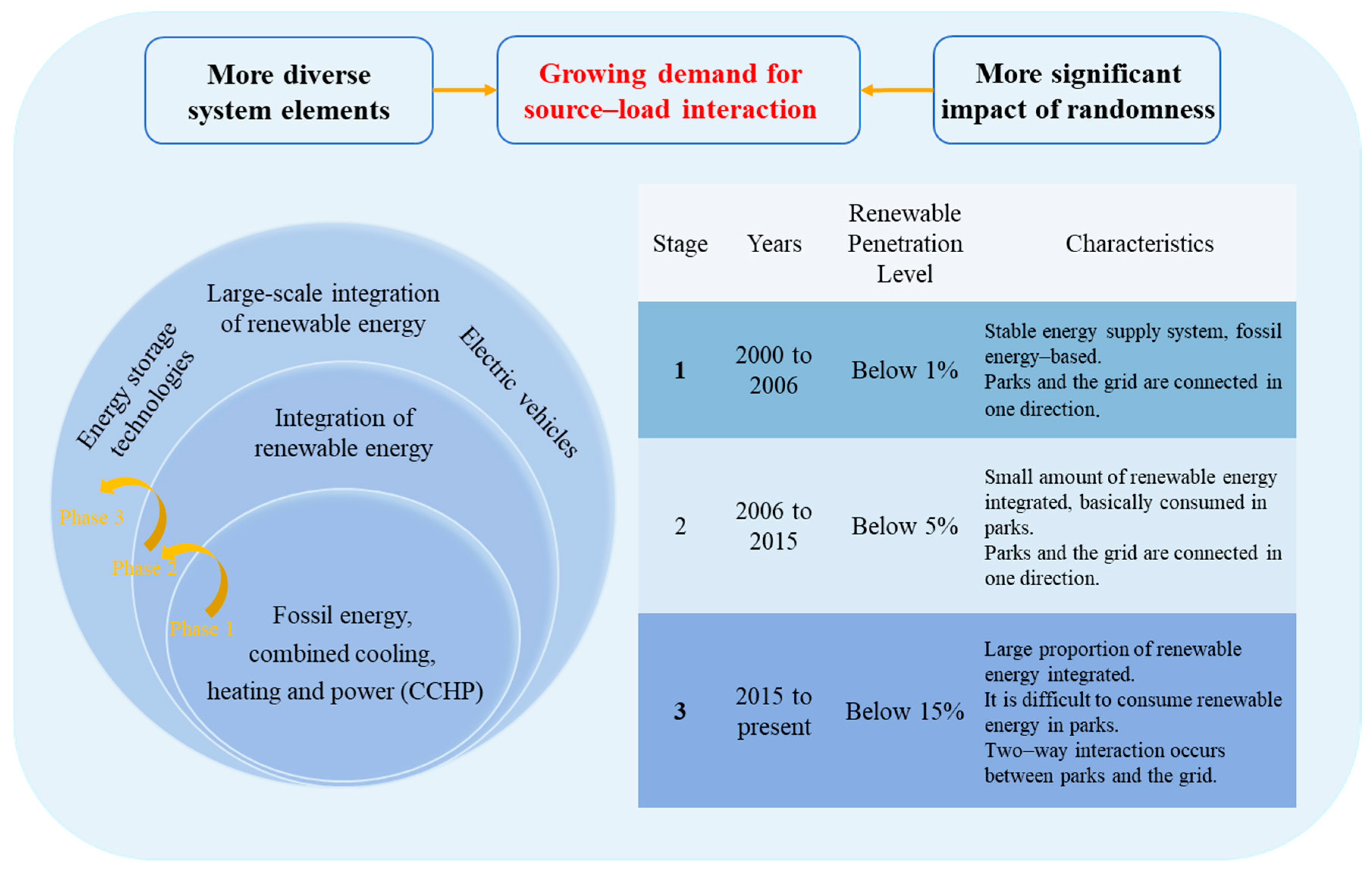
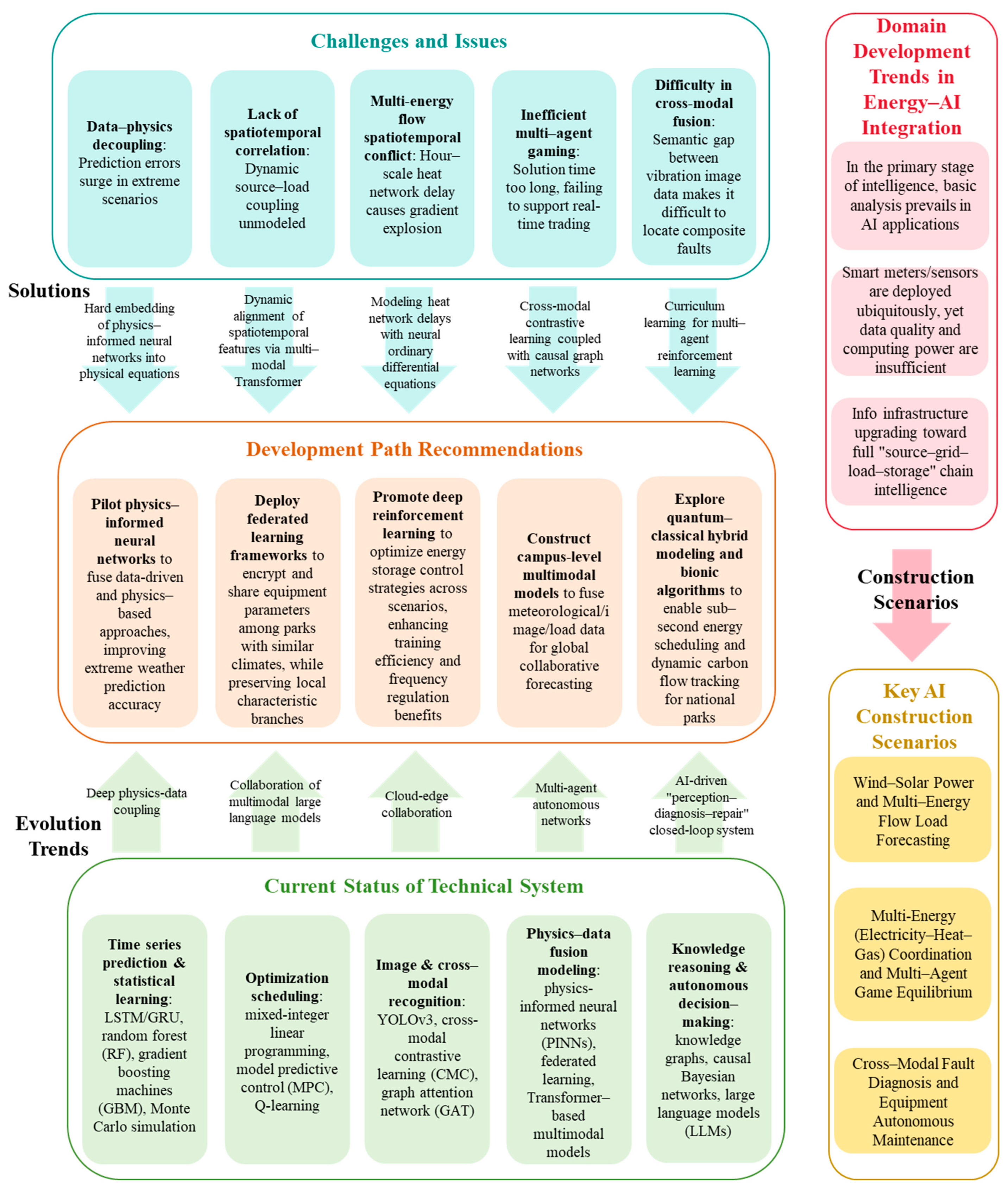
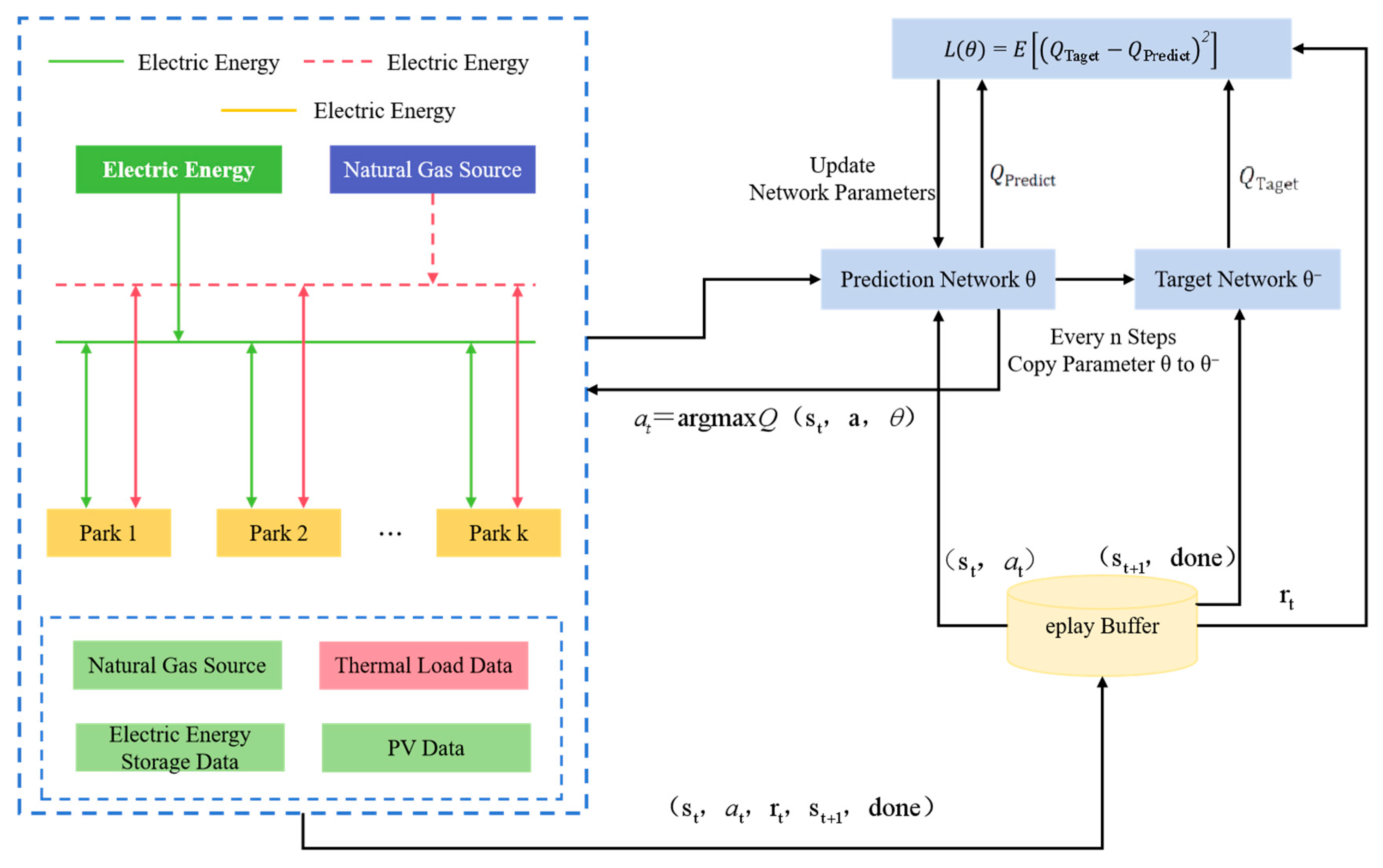
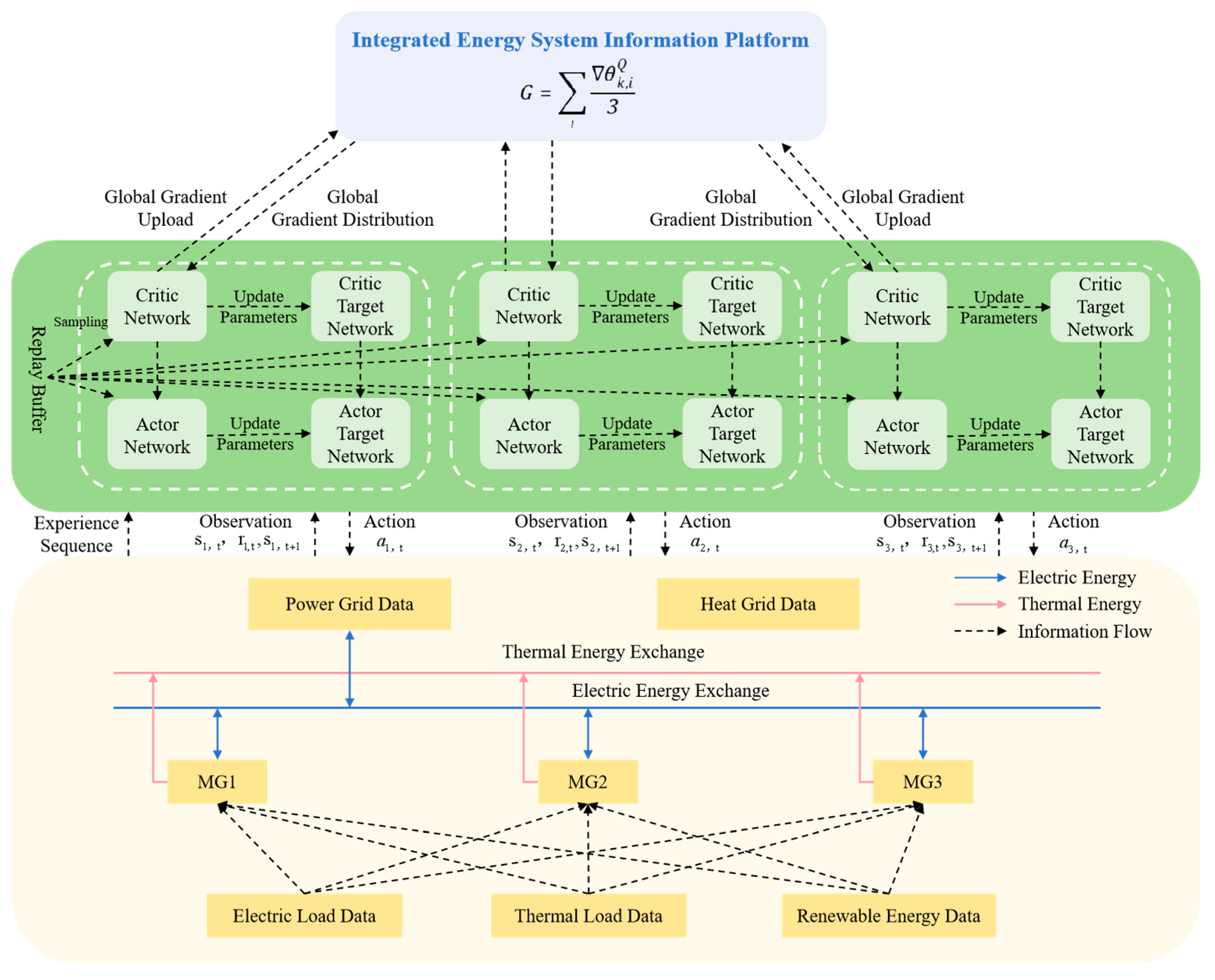


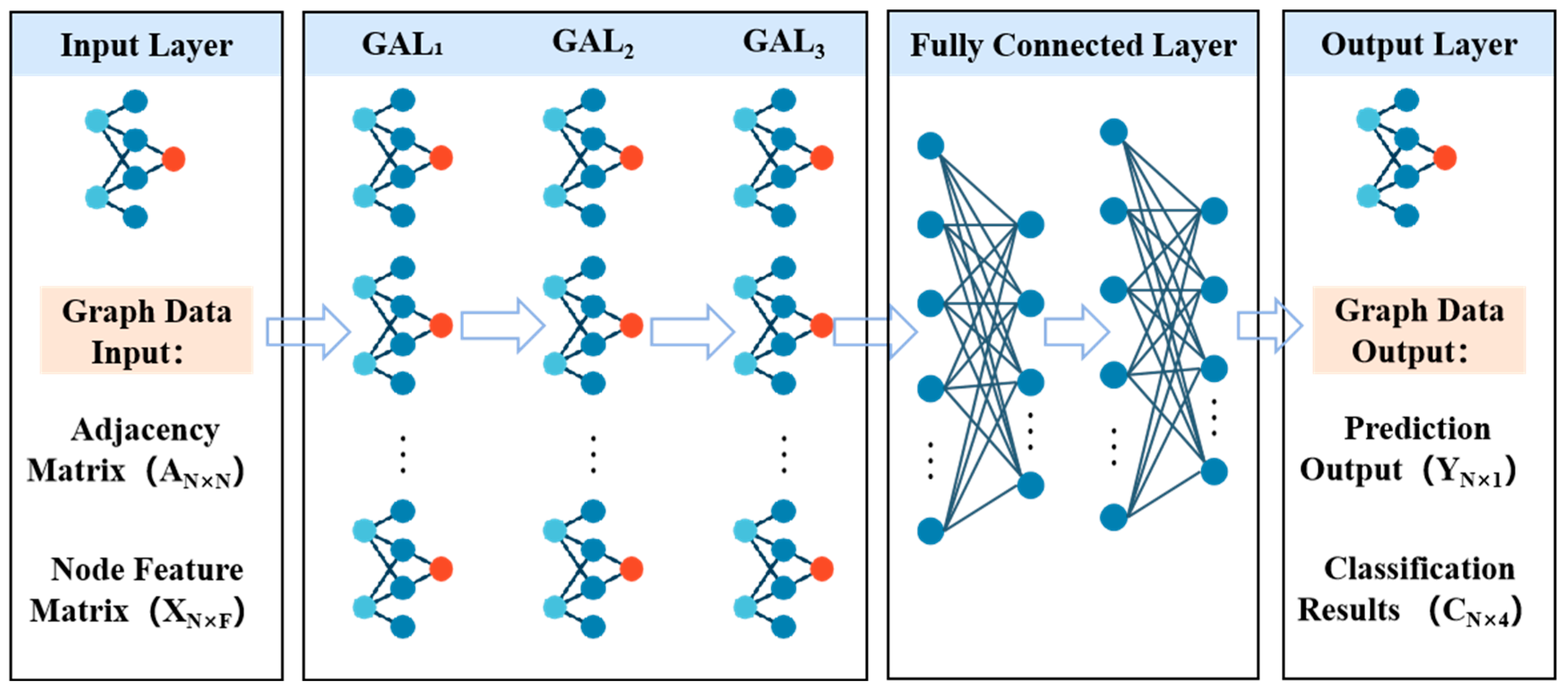
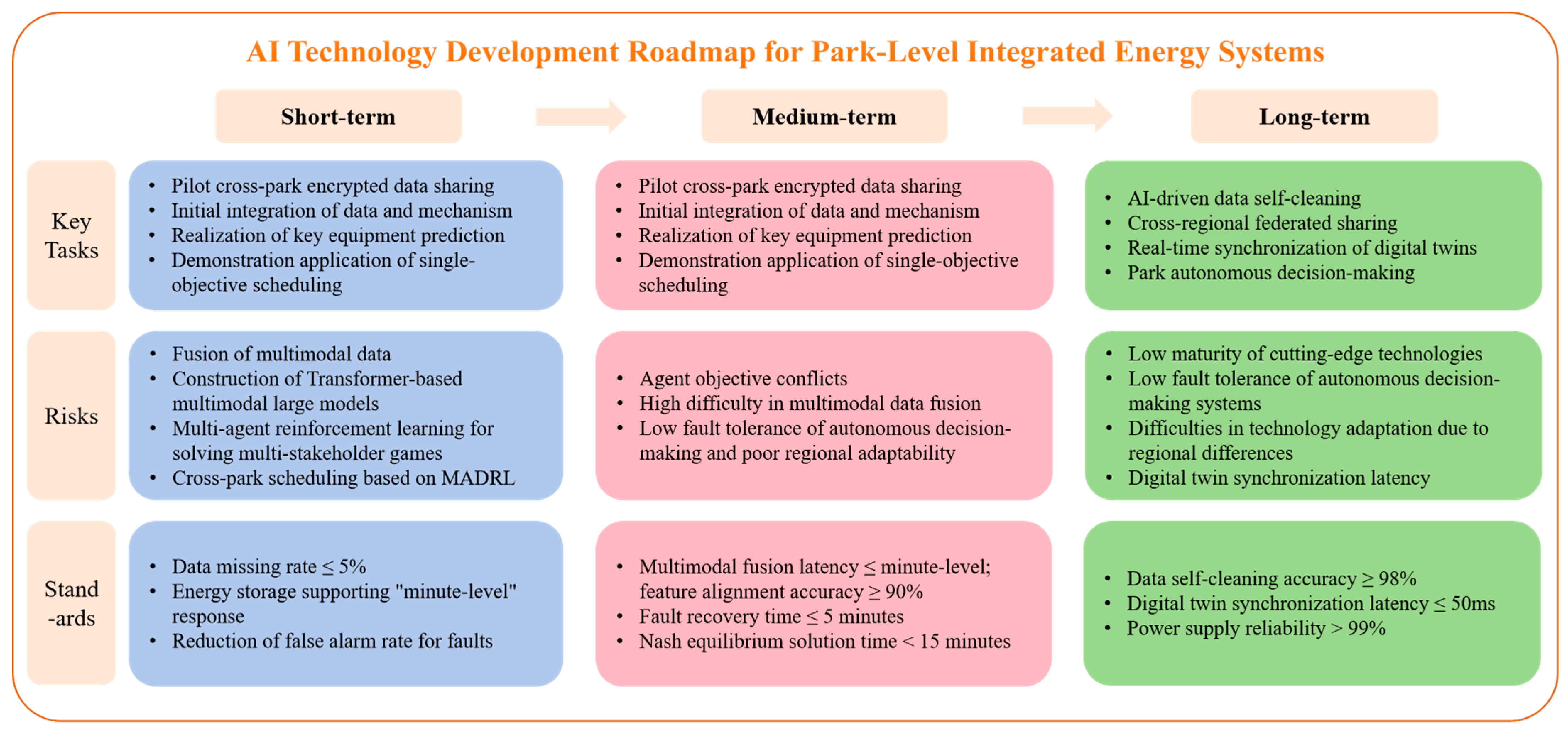
| Prediction Target | Time Scale | Data Modality | Model | Evaluation Metrics | Ref. |
|---|---|---|---|---|---|
| PV Forecasting | Short- Term | Meteorological Data Sky Images/Satellite Images Historical Data SCADA Data NWP Data Regional Wind Power Aggregation Data PVGIS Data | LSTM | RMSE/ Skill Scores (SS) | [20,21,22,23,24] |
| Stacking Ensemble Models (LSTM + GRU, SVR) | R2/NMSE/NRMSE | [25,26] | |||
| Temporal Fusion Transformers (TFT)/ LSTM with Dual-Attention Mechanisms | MAE/R2/PICP WMAPE | [26,27] | |||
| Medium-Term | RF-LSTM Hybrid Model | MAE/RMSE | [18,28] | ||
| Long- Term | Transformer + M4 Fusion Strategy | MAE/WMAPE/ R2 | [29] | ||
| Wind Power Forecasting | Short- Term | SCADA Data NWP Data Historical Data Geographic Data Meteorological Data | Bi-LSTM/ S-R CNN | MAE/CRPS/PICP NMAE/NMSE/Bias | [23,30] |
| Medium- term | xLSTM | MAE/RMSE/R2 | [31] | ||
| Long- term | Bi-LSTM/GNN | MAE/PICP | [23,30] | ||
| Load Forecasting | Short- Term | IoT Data Historical Load Data Meteorological Data Economic Data PV Data SCADA Data Electrolyzer Data PV Panel Data | LSTM families (Bi-LSTM, GRU) Shuffle Transformer Multi- Head Attention Net | MAE/NRMSE/ R2 | [32,33,34,35] |
| Medium-Term | LSTM families Parallel LSTM-MLP XGBoost | MAE/RMSE/MAPE | [36,37] | ||
| Long- Term | LSTM + XGBoost Transformer families RF, XGBoost, SVR, MLP | MAE/R2/NRMSE | [37,38] |
| Evaluation Dimension | Traditional Machine Learning (RF, GBDT, Monte Carlo Simulation) | Deep Learning (LSTM/GRU, PINNs Transformer Multi-Modal Model) | Deep Reinforcement Learning (Q-L, MADDPG, Generative Reinforcement Learning) |
|---|---|---|---|
| Data Requirements | |||
| Data Type | Structured data | Multi-source heterogeneous data | Environmental interaction data |
| Sample Size | Medium | High | Extremely high |
| Sensitivity to Data Quality | Low | High | Medium |
| Computational Complexity | |||
| Training Phase | Low | High | Extremely high |
| Inference Phase | Low | Medium–high | Medium |
| Hardware Dependence | None | Strong | Medium–high |
| Real-Time Adaptability | |||
| Inference Latency | Low | Medium–high | Medium |
| Dynamic Scenario Response | Medium | High | High |
| Scalability to Park-Scale | |||
| Small-Scale | High | Medium | Low |
| Medium-Scale | Medium | High | Medium |
| Large-Scale | Low | Medium | High |
| Core Advantages | Low data/deployment cost, strong real-time performance, suitable for basic prediction | High accuracy in multi-modal fusion/ nonlinear fitting, suitable for medium-scale multi-energy flow scenarios | Excellent multi-agent game/dynamic decision-making capabilities, suitable for large-scale cross-domain collaboration |
| Disadvantages | Complete failure in multi-modal/multi-agent scenarios | High data/computational cost, insufficient multi-agent collaboration for large-scale parks | Long training cycle, poor economy for small-scale parks |
Disclaimer/Publisher’s Note: The statements, opinions and data contained in all publications are solely those of the individual author(s) and contributor(s) and not of MDPI and/or the editor(s). MDPI and/or the editor(s) disclaim responsibility for any injury to people or property resulting from any ideas, methods, instructions or products referred to in the content. |
© 2025 by the authors. Licensee MDPI, Basel, Switzerland. This article is an open access article distributed under the terms and conditions of the Creative Commons Attribution (CC BY) license (https://creativecommons.org/licenses/by/4.0/).
Share and Cite
Tian, S.; Li, Q.; Qian, F.; Zhang, L.; Yang, Y. Overview of the Application of Artificial Intelligence in China’s Park-Level Integrated Energy System: Current Status, Challenges, and Future Paths. Energies 2025, 18, 5442. https://doi.org/10.3390/en18205442
Tian S, Li Q, Qian F, Zhang L, Yang Y. Overview of the Application of Artificial Intelligence in China’s Park-Level Integrated Energy System: Current Status, Challenges, and Future Paths. Energies. 2025; 18(20):5442. https://doi.org/10.3390/en18205442
Chicago/Turabian StyleTian, Shuangzeng, Qifen Li, Fanyue Qian, Liting Zhang, and Yongwen Yang. 2025. "Overview of the Application of Artificial Intelligence in China’s Park-Level Integrated Energy System: Current Status, Challenges, and Future Paths" Energies 18, no. 20: 5442. https://doi.org/10.3390/en18205442
APA StyleTian, S., Li, Q., Qian, F., Zhang, L., & Yang, Y. (2025). Overview of the Application of Artificial Intelligence in China’s Park-Level Integrated Energy System: Current Status, Challenges, and Future Paths. Energies, 18(20), 5442. https://doi.org/10.3390/en18205442








